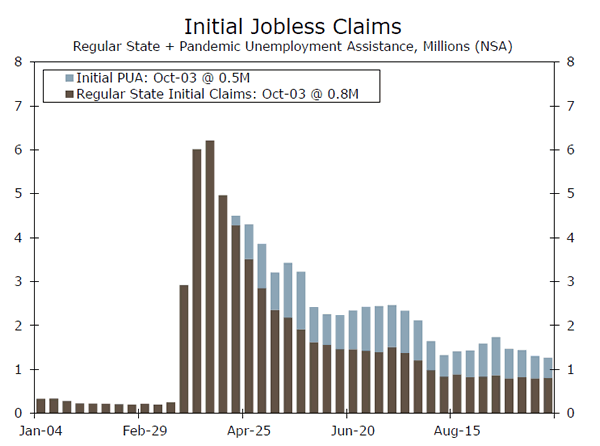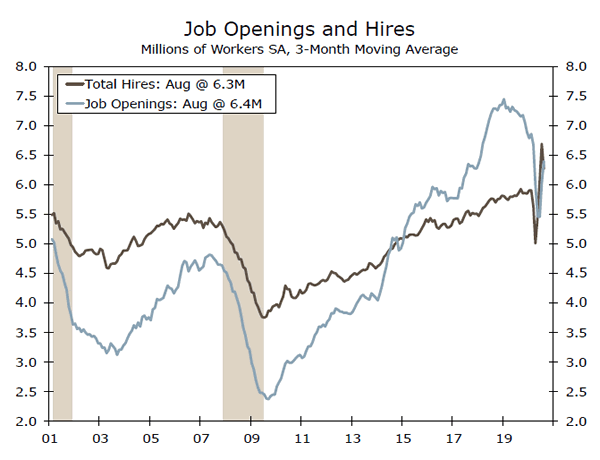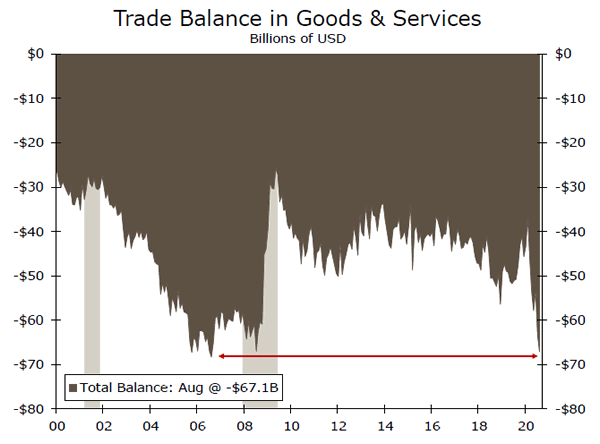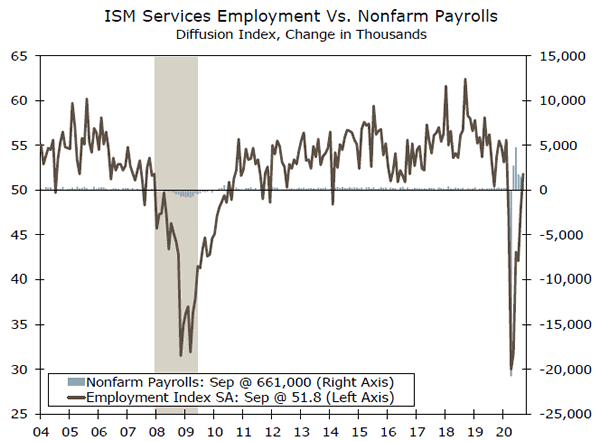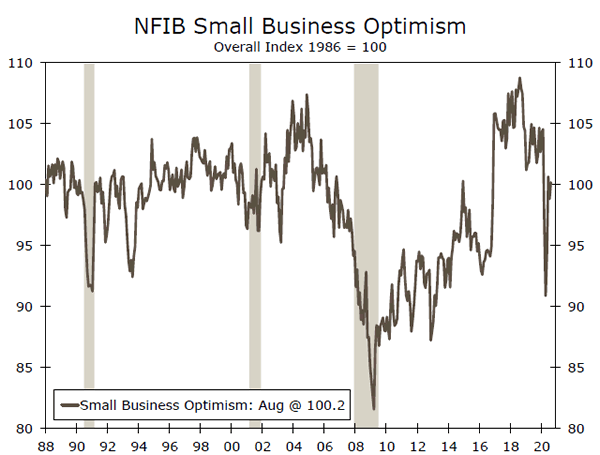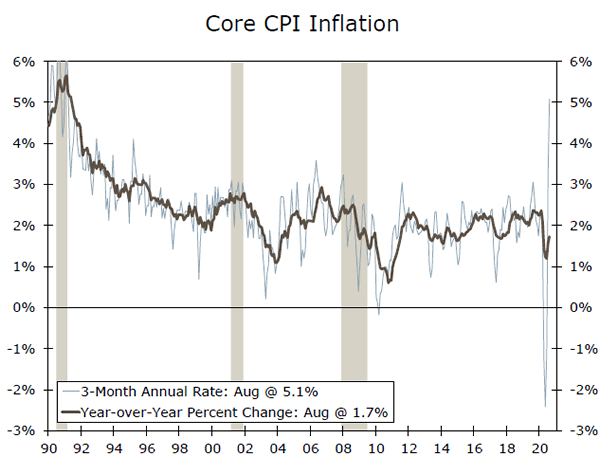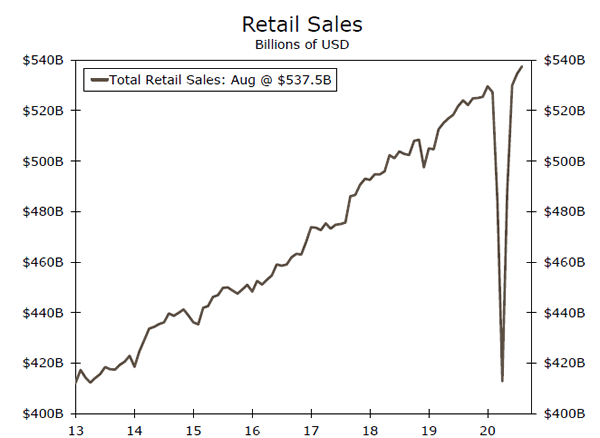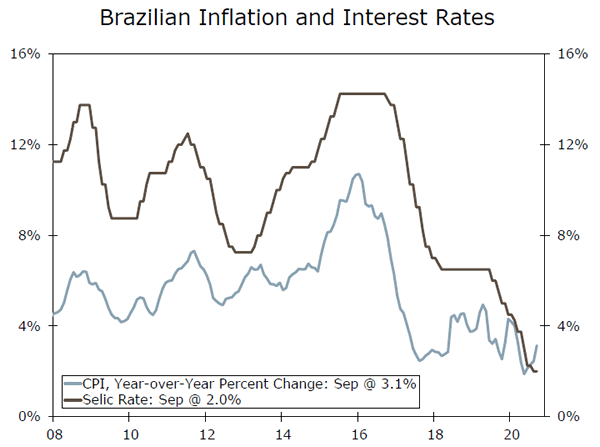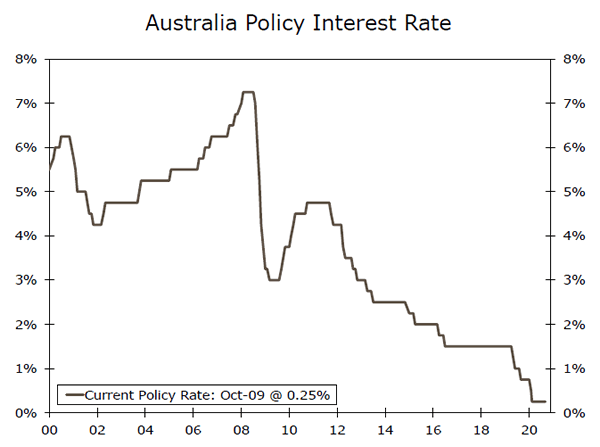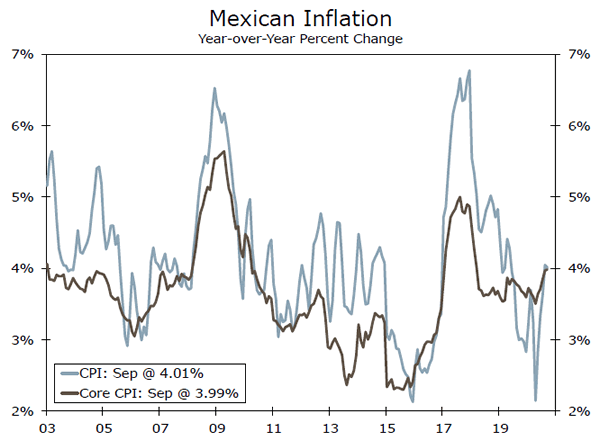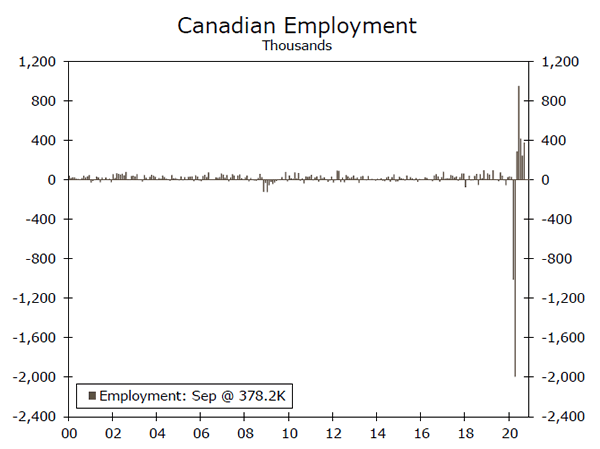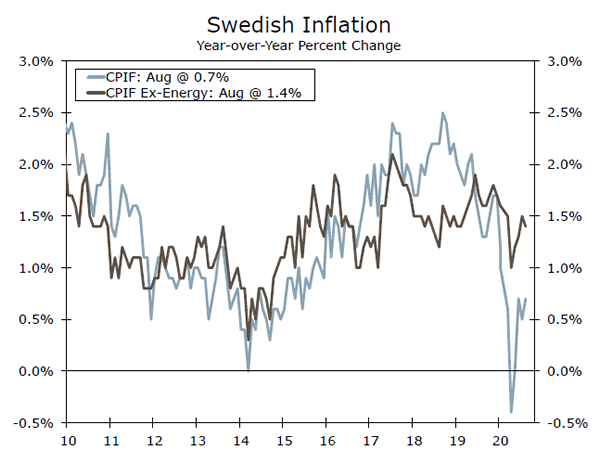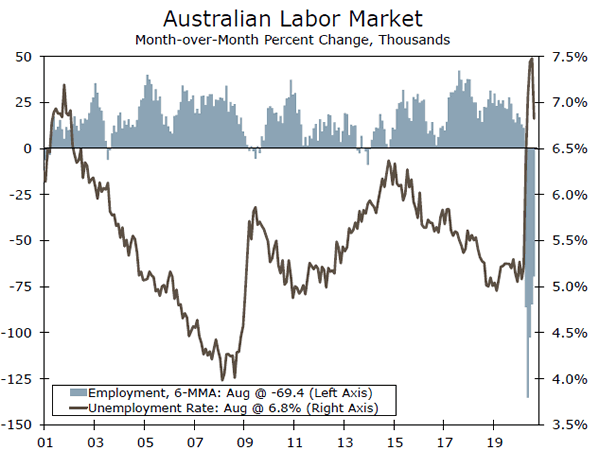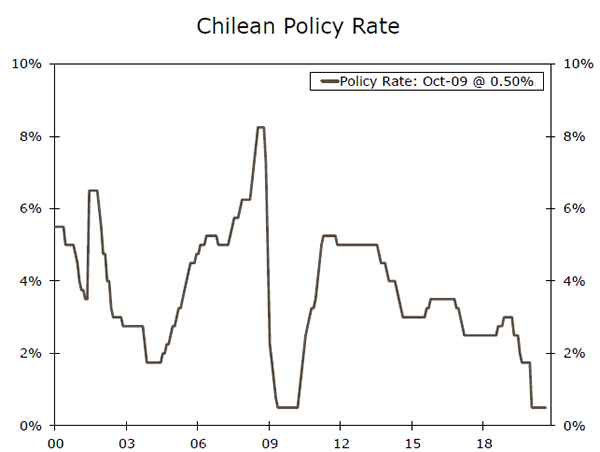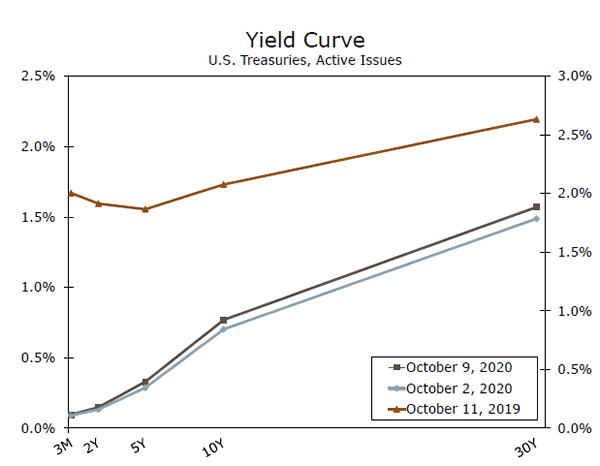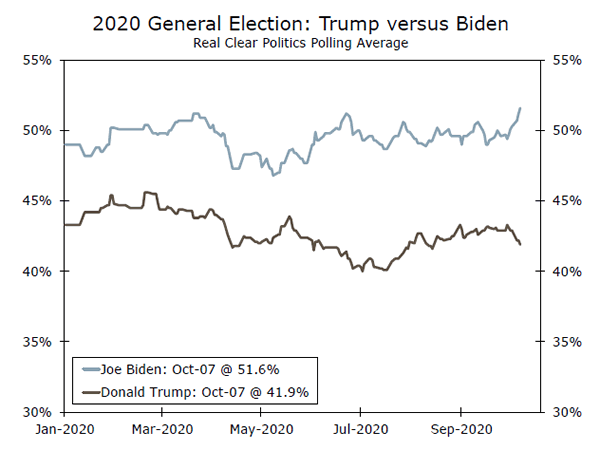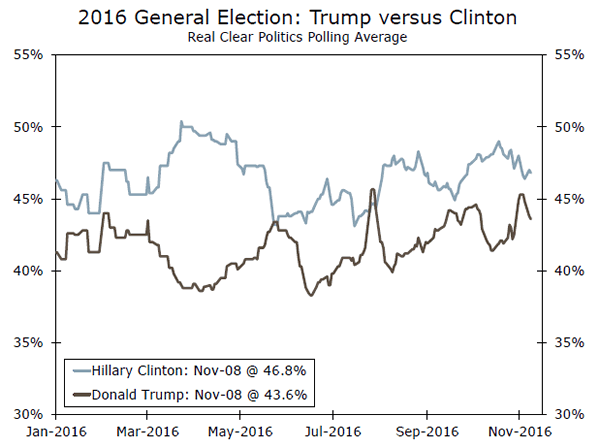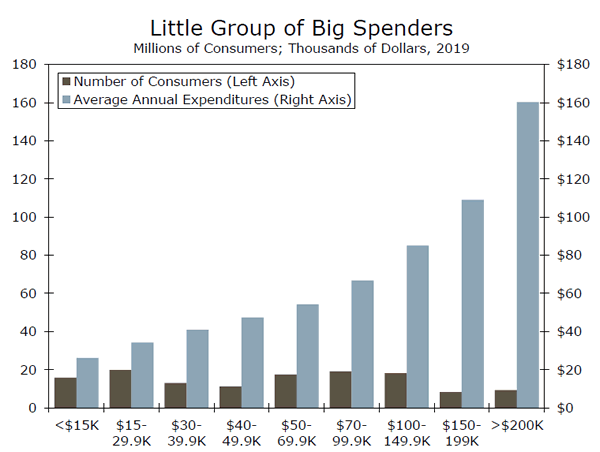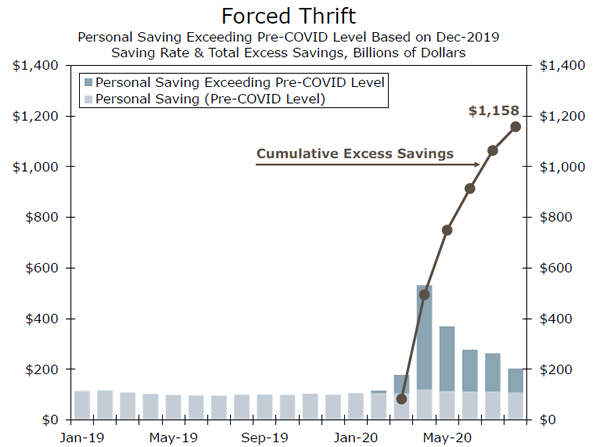U.S. Review
Slow Data Week Puts More Focus on Policy
- Weekly first time unemployment claims highlighted an extraordinarily slow week for economic news. Jobless claims fell slightly but continuing claims fell by one million.
- The ISM non-manufacturing survey handily beat expectation, rising 0.9 points to 57.8.
- Job openings, as tallied by the Bureau of Labor Statistics’ JOLTS survey, fell by 200,000 to 6.49 million in August.
- The nation’s trade deficit widened sharply to $67.1 billion in August, as consumer spending on goods has rebounded well ahead of many other nations.
All Eyes Are On Policymakers
Economic news was sparse this week, and much of what was reported reflects activity in August, which seems so long ago. We updated our forecast this week and raised our estimate for third quarter real GDP growth to a 28.6% annualized rate, which does not offset the 31.4% plunge endured during the second quarter. A number of commentators and market participants have expressed concern about the current quarter, as expectations of a second stimulus package have been repeatedly thwarted, even as rumblings of major layoffs have increased. Our current estimate has real GDP climbing at a 6.1% annualized rate in Q4, which growth should meet our expectations even if we see some additional disappointments in the stimulus battle. Failure to reach a deal on a second stimulus package likely presents more of a threat to Q1-2021 than it does the current quarter, which is set to benefit from the gradual reopening of long shuttered, large economies such as California, New York, New Jersey, Pennsylvania and North Carolina.
Federal Reserve Chair Jerome Powell re-iterated the importance of additional fiscal stimulus at his virtual address to the National Association of Business Economics earlier this week. Powell noted that the shock from the COVID-19 shutdowns impacted the economy much as a natural disaster would and has been followed by a similar rebound. He cautioned that a renewed weakening in the economy could unleash the same self-reinforcing destabilizing influences that a more typical severe recession would, which would necessitate even more monetary and fiscal stimulus. He also indicated that the risks were solidly stacked to the downside and the risk of another wave of infections would devastate the fledgling recovery.
The stimulus negotiations, which appeared dead a few days ago, now appear to be on again. The chance of a deal getting done before the election is a toss-up, but financial markets are clearly anticipating that a deal will get done either before or after the election. Bond yields have risen in anticipation of a deal and recent poll results suggests a “Blue Wave” in the presidential election. With Democrats gaining the presidency and control of Congress, future stimulus packages will likely be larger and provide a larger boost to economic growth as well as borrowing needs. Stock prices have also risen on hopes a contested election result will likely be avoided.
As far as this week’s economic reports, there was little in the data that suggest any change of direction for the economy. The persistence of jobless claims above 800,000 per week suggests that the improvement in the labor market continues to lose momentum. Many of the workers displaced at restaurants, bars and entertainment venues are likely to be out of work until more progress is made on therapeutics and vaccines, although partial staggered re-openings in California and New York will may provide some near-term relief. The stronger rebound in the ISM nonmanufacturing survey was by led gains in the important and more leading new orders component as well as a rise in the employment index back above the key 50 break-even level.
U.S. Outlook
NFIB Small Business Optimism • Tuesday
The NFIB small business optimism index increased in August, after losing ground in July. The index’s gain was broad based, with seven of its subcomponents advancing. Hiring plans, which jumped back near its pre-pandemic level, was perhaps the most encouraging amongst the advancing sub-indices. Employers added 661K net jobs in September, but the labor market’s momentum is clearly slowing. Continued improvement in small business hiring plans for September would be a welcome sign that employers are bringing in new workers, as initial jobless claims remain elevated.
It will also be interesting to watch this index as we enter the throes of election season. The survey respondents, who lean disproportionately Republican, should offer some insight on how small business owners are digesting the ongoing presidential election. During the 2016 election, the index saw a record two-month jump from October to December.
Previous: 100.2 Consensus: 100.9
Consumer Price Index • Tuesday
The Consumer Price Index has swung quite a bit over the past few months. The headline and core indices both outright declined amid the drop in demand in the first three months of the pandemic, sparking fears of further deflation. More recently, however, inflation and concerns about its trajectory have flipped, with many categories seeing payback from their lockdown-induced declines. Last month, core prices rose 0.4%, bringing the three-month annualized rate to 5.1%, the fastest pace since the early 1990s. The strength in core inflation in August, however, was less widespread than in July.
In September, we look for inflation to remain firm with headline CPI rising 0.2% on the month and core rising 0.3%. More broadly, we continue to believe that the recent pickup in inflation is more of a mean reversion than the start of a new trend. That said, the pandemic’s unique effect on individual sectors may continue to disrupt the index in the months ahead.
Previous: 0.4% Wells Fargo: 0.2% Consensus: 0.2% (Month-over-Month)
Retail Sales • Friday
Having completed the elusive V-shaped recovery, retail sales remain a focal point of the young economic expansion. Sales surged through May and June, as lockdown measures shifted consumer spending towards goods and stimulus payments helped bolster households’ income. The past two months saw continued improvement, albeit at a less torrid pace, as stimulus began to wane and new case counts soared across much of the Sun Belt. While the trend in new cases has started to pick up more recently, cases were down considerably in September compared to the summer months. Alongside improving perceptions of the labor market, this progress on the virus helped boost consumer confidence, which saw its largest jump in 17 years according to the Conference Board. The details of the Conference Board’s survey also pointed to stronger spending, with plans to buy a major appliance reaching a seven-month high. Altogether, we look for healthy retail sales growth to continue in September.
Previous: 0.6% Wells Fargo: 0.9% Consensus: 0.7% (Month-over-Month)
Global Review
RBA on Hold; Canadian Job Gains Accelerate
- The Reserve Bank of Australia held its cash rate and three-year yield target unchanged at 0.25%, as expected, but reiterated that fiscal and monetary support will be required for some time. Following the RBA meeting, Australia released its fiscal plan, which is now expected to push the cash deficit to a record high.
- Mexican inflation remained above the central bank’s upper bound inflation target of 4% in September, while Brazil’s September IPCA consumer prices rose to 3.14% year-over-year. Elsewhere, Canadian employment growth unexpectedly accelerated in September, while the unemployment rate slid to 9.0%.
RBA Signals Additional Easing
The Reserve Bank of Australia (RBA) met earlier this week, and opted to hold its cash rate and three-year yield target unchanged at 0.25%. In the accompanying statement, the central bank noted that labor market conditions have improved somewhat over the past few months, but unemployment and underemployment will likely remain high for an extended period of time. Policymakers indicated again that fiscal and monetary support will be required for some time and it will consider how additional easing could support employment as the economy re-opens. Following the announcement, the Australian dollar initially jumped as some market participants were looking for the RBA to hint at an interest rate cut in the short-term. We currently are not calling for any further policy changes from the RBA, but we see the risks tilted toward some form of more accommodative policy.
Shortly after the RBA’s meeting, the Australian government released its federal budget plan which is expected to create jobs and help the economy recover from the COVID-19 induced recession. The underlying cash deficit is now expected to rise to a record A$213.7B, roughly 11% of GDP in FY-2021. Under the governments’ program, gross debt is expected to be 44.8% of GDP at the end of 2020-2021, while net debt will peak at 43.8% of GDP at the end of the forward estimates (2024).
Mexican Inflation Remains High in September
Mexico’s September CPI inflation remained above the central bank’s target upper bound of 4% for the second consecutive month. Prices rose 4.01% year-over-year, from 4.05% the previous month, slightly below consensus estimates, while core CPI was little changed at 3.99% year-over-year. Food, beverage and tobacco inflation remained elevated at 7.38%, while electricity and regulated utilities inflation also increased. Meanwhile, core inflation was boosted in part by merchandise inflation which rose to 5.40%. We believe that the rise in inflationary pressures will keep interest rates on hold for the time being, and continue to look for a less dovish central bank than what markets are currently pricing in.
Meanwhile, in Brazil, the September inflation report showed an uptick in inflation. IPCA consumer prices rose to 3.14% year-overyear, exceeding market expectations and marked the fourth straight monthly increase. The food and beverage component remained high, rising to 11.79% year-over-year, while communication and personal expenses prices rose to 3.15% and 2.55%, respectively. Meanwhile, Brazil’s retail sales rose 3.4% month-over-month in August, exceeding market expectations for a 3.0% gain.
Canadian Job Report Exceeds Market Expectations
September saw another positive jobs report from Canada as employment rose 378.2K, more than expected and the fifth consecutive monthly increase. Employment is now just 3.7% below its pre-COVID, February level. The details of the report were encouraging as well with most of the increase in full-time employment, which rose 334K, while part-time employment increased 44.2K. Total hours worked also rose 1.9% month-overmonth, while the unemployment rate declined to 9.0%. The Canadian labor market has made solid progress in recovering its losses from the first half of 2020 and should support the economic recovery going forward.
Global Outlook
Sweden CPIF Inflation • Tuesday
Swedish inflation has been lower than expected in recent months amid falling electricity and fuel prices, which weighed on headline and underlying inflation rates. In August, Sweden’s headline CPIF inflation rose ti 0.7% year-over-year, mainly driven by a significant jump in electricity prices, while CPIF ex energy inflation rose to 1.4% year-over-year, down from 1.5% in July. However, both measures still remain well below the central bank’s target rate of 2%. As inflation has receded, so have the Riksbank’s inflation projections. The central bank looks for CPIF inflation to rise to just 1.2% and 1.3% in 2021 and 2022, respectively, noting that the rise in inflation in 2021 will likely be subdued in part by a firmer Swedish krona. We also look for the headline inflation to hold below the 2% target through 2022. Next week, the headline CPI is expected to rise 0.6%, while headline and core CPIF inflation is expected to rise 0.6%, and 1.2%, respectively.
Previous: 0.7% Consensus: 0.6% (Year-over-Year Percent Change)
Australia Employment • Wednesday
Australia’s September employment report will provide the latest read on the labor market amid the renewed lockdown measures imposed in Victoria. Following especially large job declines in the second quarter, employment appears to be recovering. Employment rose more than expected in August, jumping by 111,000, marking the third straight monthly gain. The details of the report indicated full-time jobs and part-time jobs rose by 36,200 and 74,800, respectively, while the unemployment rate slid to 6.8%. The increase in jobs came even as employment in Victoria decreased by 42,400 and the unemployment rate increased to 7.1%. As restrictions are relaxed and new COVID-19 cases decline, we expect the labor market to continue to recover. Next week, we will be focused on the split between full-time and part-time jobs, and the change in total hours worked, which should provide some insight into how the labor market is holding up in September.
Previous: 111,000 Consensus: -35,000
Chile Policy Decision • Thursday
At its September policy meeting, Chile’s central bank held its policy rate steady at 0.50%, matching consensus expectations. The board did not announce any new stimulus measures, but plans to continue its asset purchase program. In the accompanying statement, the central bank reiterated that it will maintain strong monetary stimulus for an extended period of time to ensure that its objectives are achieved. It expects the interest rate to remain at its minimum level over most of the two-year forecast period, slightly different language than in the past few meetings. This suggests policymakers could start slowly increasing rates at the end of its forecast period. Next week’s monetary policy announcement should provide some further details of the central bank’s monetary policy outlook. Although the effects of COVID-19 are likely to weigh of the Chilean economy and inflation is trending toward the lower end of the central bank’s target range, we believe the monetary easing space is especially limited in Chile and the central bank is likely to remain on hold next week.
Previous: 0.50% Wells Fargo: 0.50% Consensus: 0.50%
Point of View
Interest Rate Watch
Treasury Yields Holdings Gains
The U.S. Treasury yield curve has steepened a bit over the past couple weeks. As of this writing, the 10-year Treasury yield was about 11 bps higher than it was two weeks ago, and 30-year Treasury bond yields were up about 17 bps (top chart).
The initial increase in yields seemed to stem from the revival of COVID relief negotiations between Treasury Secretary Steven Mnuchin and Speaker of the House Nancy Pelosi. Talks between the two were at a standstill, but around the time yields began to rise negotiations seemed to be gathering momentum.
However, the prospects for a COVID relief bill were dashed on Tuesday when President Trump tweeted that he was asking his negotiators to stand down until after the election, evidently because the Democratic proposals were still a bridge too far. Despite the collapse in talks, Treasury yields generally held their gains. This is perhaps even more impressive given that the FOMC minutes released this week signaled that bigger and longer-dated purchases of Treasury securities could be in the offing.
What, then, could be keeping yields at their current levels? Perhaps one explanation is the growing prospects of a Democratic sweep in the elections. Polling data released this week have been especially favorable to Joe Biden, who has pushed his lead in the Real Clear Politics polling average to nearly ten points (middle chart). This is well above Clinton’s high water mark of seven points in October 2016, and well above the roughly three point polling lead she maintained on election night (bottom chart).
Of course, as we have stated repeatedly, the state of the race can certainly change between now and Election Day. But, the clock is ticking. We are just 25 days from Election Day, and President Trump remains in a bigger hole than the 3-4 point polling deficit he overcame in 2016. A Democratic sweep of the White House and Congress could yield another sizable round of COVID relief. Thus, even though additional fiscal stimulus may not come before the election, the odds of it coming at some point in the next couple quarters are on the rise, in our view, just like Treasury yields.
Credit Market Insights
Surprise Tumble in Consumer Credit
We would not have been surprised to see a pick-up in consumer borrowing in August as the $600 weekly top-up to normal state unemployment benefits expired at the end of July. Consumer credit, however, fell $7.2B over the month—far from market expectations—following upwardly revised gains in June and July. The recent drop was entirely driven by a $9.4B decrease in revolving credit (mostly consisting of credit card debt), marking the category’s sixth consecutive monthly decline. Meanwhile, non-revolving credit, mostly comprised of auto and student loans, continued to climb, increasing $2.2B in August.
Continued weakness in revolving credit suggests that consumers are navigating credit card purchases with caution. In a recent report, our group highlighted that the personal saving rate during this downturn has far exceeded the averages seen from 2000-2019. In that context, households appear better equipped to stay afloat during this cycle without having to rely too heavily on borrowing. Furthermore, a major share of banks reported tightening lending standards on all categories of consumer loans in the second quarter. In combination with high unemployment and uncertainty about job prospects, consumers are likely unwilling to take on additional credit in general. Looking ahead, we expect to see a slowing in the growth rate of consumer spending, but not an outright decline. Accordingly, revolving credit may continue to subside as consumers moderate their consumption in the coming months.
Topic of the Week
Lost Benefit Analysis
Stimulus talks dominated the economic news yet again this week as Congress continues to debate another COVID-relief bill. Thus far, federal transfers have played a crucial role in bolstering incomes and spending in the face of the ongoing pandemic. Now, as the stimulus has started to wane, many are concerned that consumer spending will fall sharply, bringing the six-month old recovery with it. In our view, a cut in additional stimulus is a clear negative for consumer spending, but it will only slow rather than stop spending growth because of two primary factors.
First, a closer look at the composition of spending by income group tells us there is a small group of big spenders that have largely sidestepped the worst of the economic fallout. The record job losses this year have been concentrated in lower paying, close-contact service industries, while many higher-paying jobs have fared better. Despite typically spending a larger share of their income, lower-income households represents a relatively small share of aggregate spending in the U.S. economy. In fact, the top 10% of earners (90-100% income cohort) account for nearly half of total personal outlays in the United States. While this statistic is disheartening from an income inequality perspective, the “little group of big spenders” concept suggests aggregate U.S. consumer spending should endure in the months ahead.
Second, as the bottom chart illustrates, the saving rate has jumped far ahead of its pre-COVID level, due to expanded government transfers and consumers’ inability to spend on many services. While higher income groups generally account for the bulk of saving, saving rates appear to have increased across all income cohorts in the second quarter. Moreover, the saving rate had been moving higher across all income groups for much of the past cycle. So, even when discounting the recent savings surge due to the mechanics of lockdowns and stimulus, households had a higher stock of savings than they did heading into the 2007-2009 recession.




